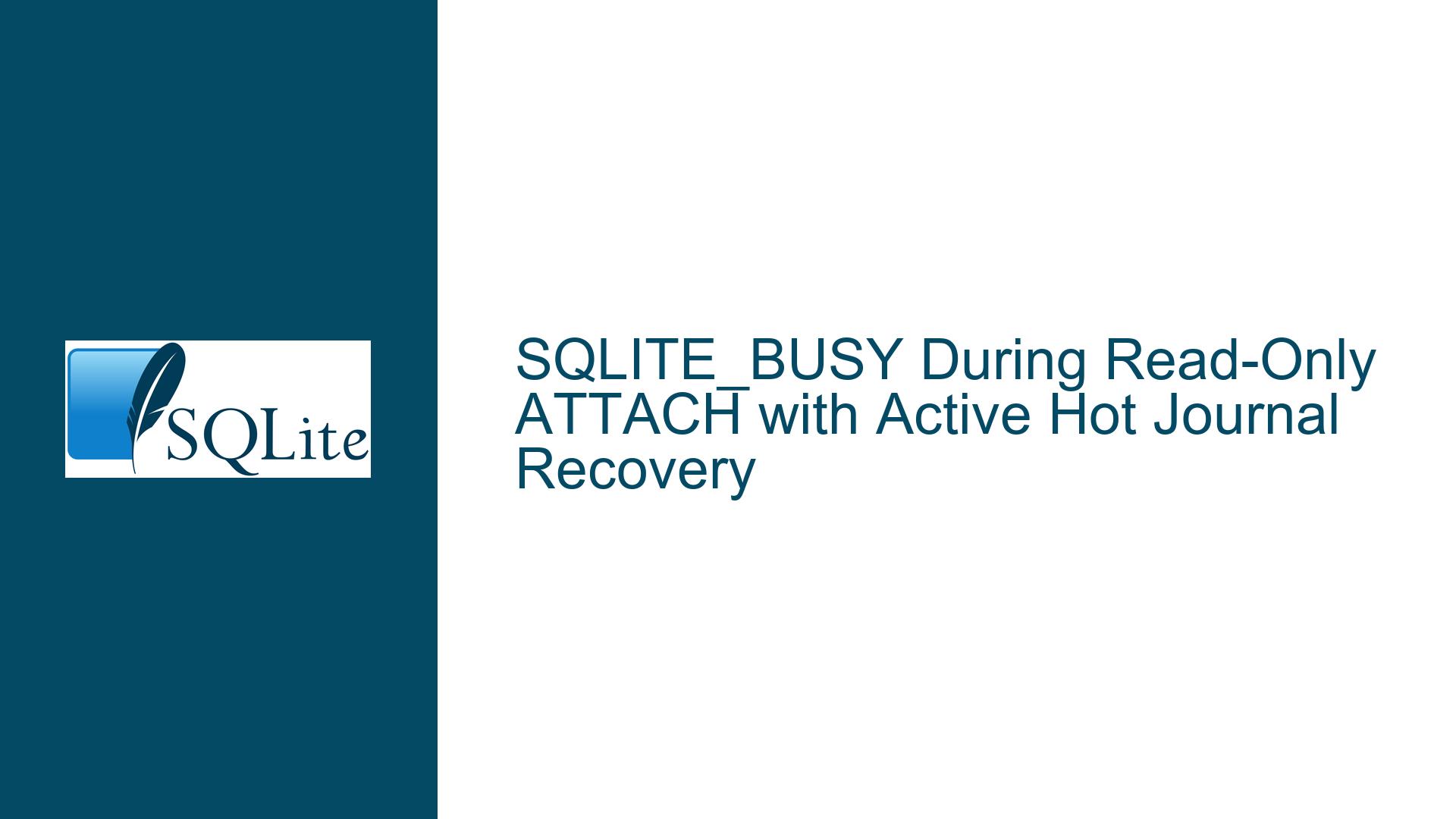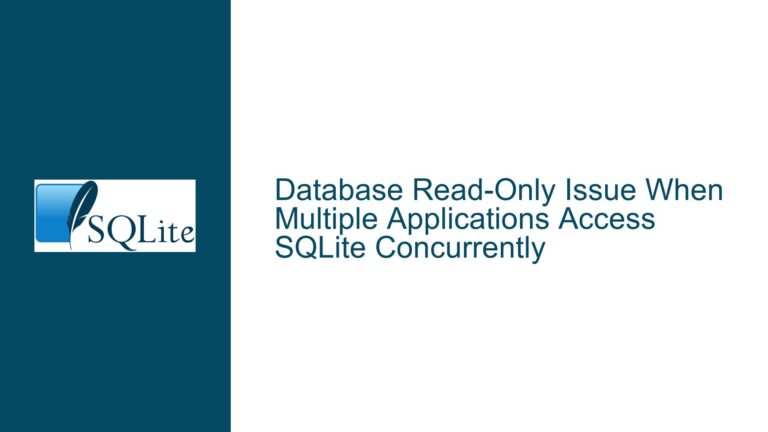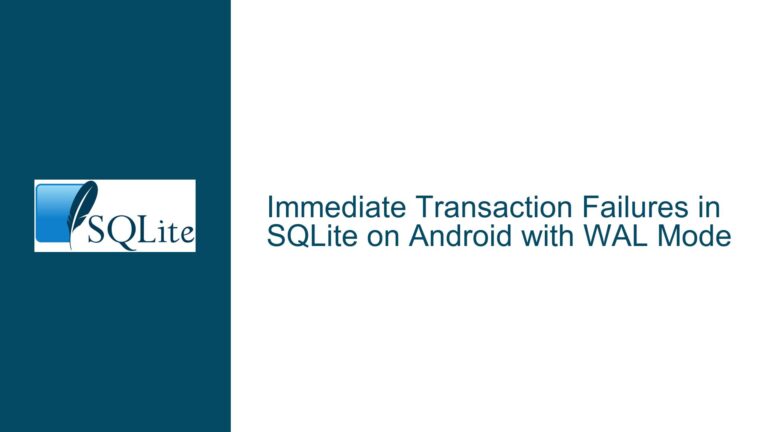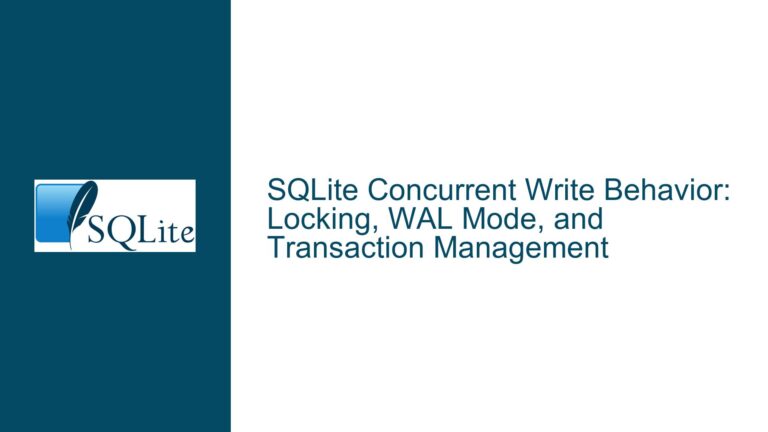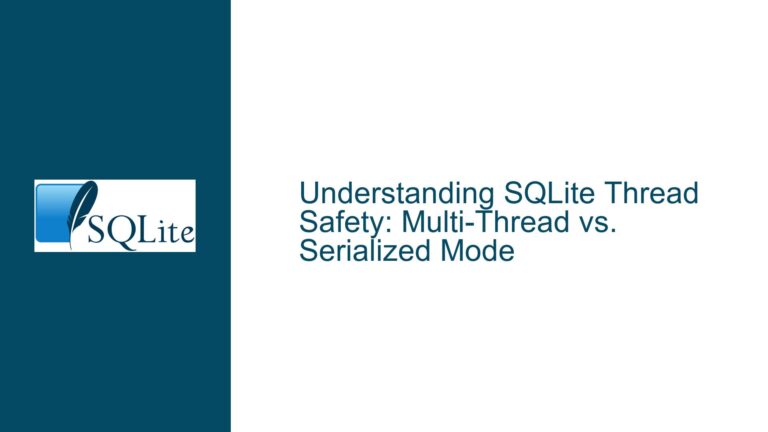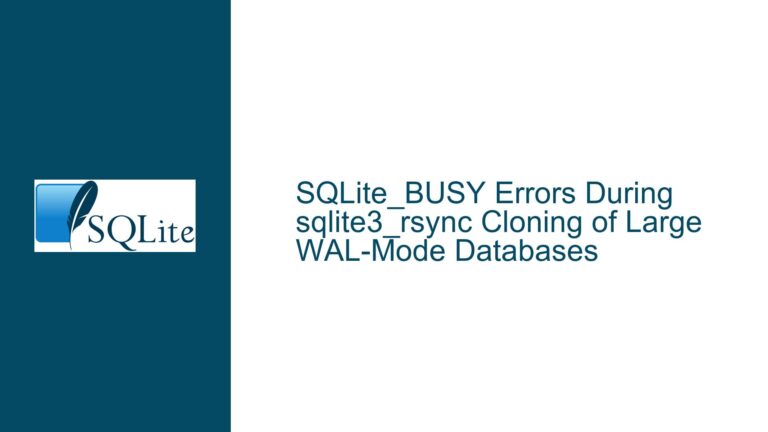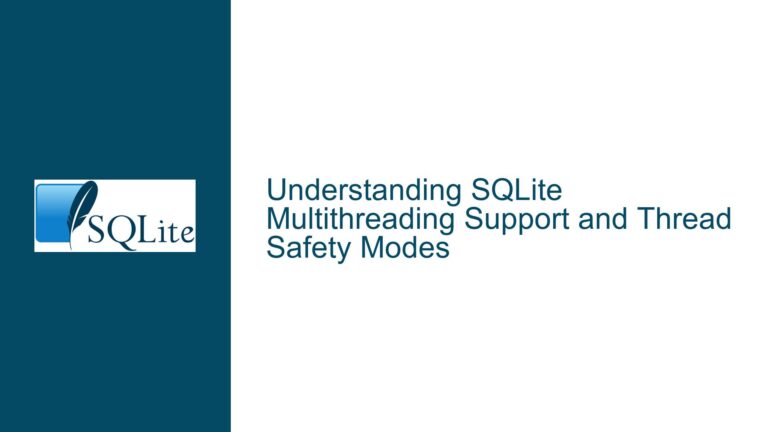SQLITE_BUSY During Read-Only ATTACH with Active Hot Journal Recovery
Database Lock Contention Between Hot Journal Recovery and Read-Only Attachment
Concurrent Operations and Lock State Fundamentals
The core issue occurs when two processes interact with a SQLite database during distinct phases of operation:
- Process A is actively recovering the database from a hot journal (automatic recovery triggered by crash recovery protocol)
- Process B attempts to attach the same database file in read-only mode using URI parameters
This creates a temporal window where SQLite’s locking protocol categorically denies access to Process B with immediate SQLITE_BUSY instead of invoking the configured busy handler. The behavior stems from fundamental design constraints in SQLite’s concurrency model and crash recovery implementation.
Hot journal recovery requires exclusive access to establish database consistency before permitting new connections. Read-only attachments must validate database state integrity through file header checks and journal verification, which temporarily requires shared locks. When these operations overlap, SQLite employs deadlock-avoidance heuristics that bypass busy handlers to prevent system-wide stalls.
Key components influencing this interaction:
- Write-Ahead Log (WAL) vs Rollback Journal Modes: The original scenario uses classic rollback journaling (implied by .sqlite-journal file), where crash recovery follows different locking sequences than WAL
- Lock Progression Hierarchy: Shared → Pending → Reserved → Exclusive lock states with strict escalation rules
- Journal Recovery Semantics: Mandatory database lock acquisition during hot journal processing to guarantee atomic recovery
- URI Parameter Handling: The ‘mode=ro’ flag triggers specific file open flags that interact with VFS layer locking
Lock Escalation Deadlock Potential During Recovery Sequences
1. Hot Journal Recovery Lock Acquisition Pattern
When Process A detects a hot journal (foo.sqlite-journal exists), it initiates recovery through this sequence:
- Obtain SHARED lock on database file
- Verify journal header validity
- Escalate to PENDING lock to block new SHARED lock holders
- Replay journal entries into database
- Delete hot journal file
- Release locks
Critical phase occurs at step 3 (PENDING lock acquisition). Once PENDING is held, new SHARED lock requests are queued behind existing lock holders. However, Process B’s ATTACH command arrives during this narrow window:
2. Read-Only Attachment Lock Requirements
Process B’s ATTACH 'file:foo.sqlite?mode=ro' AS foo operation executes:
- Open database file with O_RDONLY flag
- Check for hot journal (required even for read-only)
- Attempt SHARED lock acquisition
- If hot journal exists, initiate recovery (conflict with Process A)
- Validate schema and prepare read-only statement compilations
The collision occurs when:
- Process A holds PENDING lock during journal replay
- Process B attempts SHARED lock acquisition (blocked by PENDING)
- Process A requires exclusive access to complete recovery
- Process B’s SHARED lock attempt prevents Process A from progressing
SQLite detects this circular dependency and categorically returns SQLITE_BUSY without invoking busy handlers. This prevents deadlocks where both processes would wait indefinitely for each other’s locks.
3. URI Parameter Implications for Lock Negotiation
The ‘mode=ro’ URI parameter introduces critical behavioral differences vs default read/write opens:
- O_RDONLY File Descriptor: Limits VFS operations to read-only system calls
- Immutable Database Assumption: When combined with ‘immutable=1’, skips journal checks
- Locking Shortcuts: Read-only connections may bypass certain lock state validations
However, the presence of a hot journal forces even read-only connections to participate in recovery, as an unrecovered database cannot be safely read. This creates a temporary requirement for write-like locking during what’s nominally a read operation.
Protocol-Driven Solutions and Workarounds
1. Coordinating Database Access During Recovery
Solution: External Synchronization Primitive
Implement application-level coordination using OS mutexes or file locks before attaching databases:
/* Pseudocode for Process B */
retry:
lock = acquire_external_lock("foo.lock");
rc = sqlite3_open("file:foo.sqlite?mode=ro", &db);
if (rc == SQLITE_BUSY) {
release_external_lock(lock);
sleep(retry_delay);
goto retry;
}
Tradeoffs:
- Adds external dependency for lock management
- Risk of priority inversion if recovery takes longer than timeout
- Requires modification to both writer and reader processes
2. Bypassing Hot Journal Checks for Read-Only Connections
Solution: Immutable Database Flag
If the database is guaranteed not to change (e.g., static data), use:
ATTACH 'file:foo.sqlite?mode=ro&immutable=1' AS foo
This skips journal checks entirely, assuming:
- No active writers exist
- Database file contents are frozen
- Journal files are irrelevant
Caveats:
- Violating immutability causes undefined behavior
- Not suitable for databases undergoing modifications
3. Custom Busy Handler with Escalating Backoff
Solution: Implement Application-Level Retry Logic
Wrap attachment attempts in a retry loop with exponential backoff:
# Python example
max_retries = 5
base_delay = 0.1 # 100ms
conn = None
for attempt in range(max_retries):
try:
conn = sqlite3.connect('file:foo.sqlite?mode=ro', uri=True)
break
except sqlite3.OperationalError as e:
if 'database is locked' not in str(e):
raise
time.sleep(base_delay * (2 ** attempt))
if not conn:
raise RuntimeError("Failed to attach database after retries")
Advantages:
- No external dependencies
- Handles transient lock contention
- Configurable retry policy
4. Filesystem Monitoring for Journal Status
Solution: Watch for Journal File Deletion
Poll filesystem for presence of foo.sqlite-journal before attaching:
# Shell monitoring example
while [ -f foo.sqlite-journal ]; do
sleep 0.1
done
sqlite3 'file:foo.sqlite?mode=ro'
Implementation Notes:
- Requires filesystem notification support (inotify on Linux) for efficiency
- Race conditions possible between check and actual attachment
- Platform-specific code complexity
5. Modifying Journaling Mode to WAL
Solution: Convert to Write-Ahead Logging
WAL mode separates writer and reader lock states, potentially avoiding the contention:
PRAGMA journal_mode=WAL;
Analysis:
- Writers use WAL file instead of journal
- Readers can access main database while writes proceed
- Hot journal recovery semantics differ
- Requires application support for WAL maintenance
Caveats:
- Not all SQLite environments support WAL (e.g., certain embedded platforms)
- Introduces WAL file management overhead
6. VFS Layer Customization for Lock Prioritization
Advanced Solution: Custom VFS Implementation
Override default locking behavior to prioritize recovery operations:
// Partial VFS implementation sketch
static int xLock(sqlite3_file *pFile, int lock) {
if (lock == SQLITE_LOCK_SHARED) {
// Check if recovery is ongoing
if (recovery_in_progress(pFile)) {
return SQLITE_BUSY;
}
}
return default_vfs.xLock(pFile, lock);
}
Considerations:
- Requires deep SQLite internal knowledge
- Risk of introducing new deadlock scenarios
- Difficult to maintain across SQLite versions
Concluding Recommendations
For most applications, combining immutable flag usage (where appropriate) with application-level retry logic provides the best balance between reliability and complexity. Mission-critical systems should implement external synchronization primitives coordinated with database recovery events. WAL mode adoption eliminates this specific contention scenario but requires evaluating overall application write patterns.
Developers must carefully audit SQLite version-specific behaviors, as lock escalation heuristics evolve across releases. Testing under high-concurrency simulated loads remains essential to validate chosen mitigation strategies.
